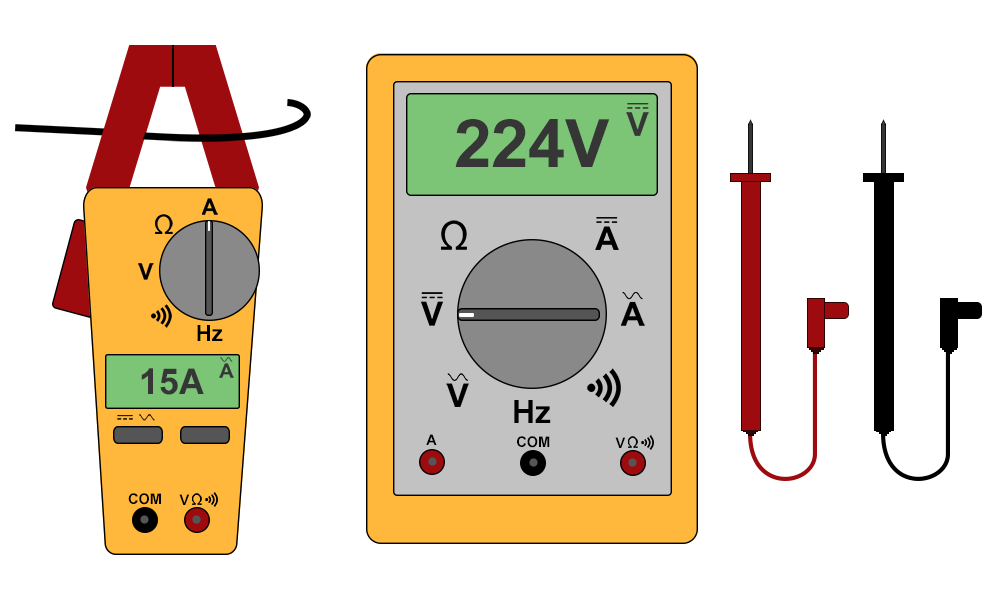Multimeters
Multimeters are the most important tool one has when working with electricity. A multimeter allows you to measure all of the important characteristics of a circuit or electrical system, which enables you to work safely and verify if a circuit is working correctly. There are many different types of multimeters that offer a variety of different functions. They range in cost dramatically as well. All multimeters, even cheap ones, should be able to perform the basic measurements that are required to do electrical work: voltage, current, resistance, conductivity and frequency. That being said, it is important to make sure that the multimeter you are using is rated for use with the highest potential voltage and current that you intend to measure. If a multimeter is not rated to function under the conditions of use, it could destroy the multimeter and potentially cause severe harm. Multimeters are classified into various categories that inform users about their ability to handle excess voltages and current. These ratings go from the lowest rating being Category I (for use with small electronics with limited current/voltage sources) to Category IV (for use at the connection to the utility grid and all outdoor conductors)[1].outdoor conductors coming from the utility grid). For small off-grid PV systems at least a Cat II - 600V multimeter is recommended and should be fairly cheap.
Contents
Functions of a multimeter
Voltage
Current
Resistance
Conductivity
Frequency
Types of multimeters
Traditional handheld multimeter
These are the most common and economical multimeters on the market. For a low price they can perform many different functions and, if it is a decent brand, should be fairly accurate. These multimeters rely on probes to take all of measurements. This means that the amount of current that they can measure, as it has to pass through the multimeter, is often limited to 10-15A. There is an internal fuse that will be destroyed if one attempts to pass excess current through the multimeter. This means that one cannot take current measurements of circuits for which the amount of current flowing is not already known. Nor can one take measurements of asource that can supply high amounts of current - like an outlet or a battery - as the multimeter provides a low resistance path for the current to pass through. If measuring currents near or in excess of 10A may be required, then it is necessary to get a clamp meter.
These meters come in two types:
Manual-ranging
This type of multimeter requires the user to select the maximum voltage, current, or resistance in order to take a measurement. If too high of a range is used, it will lead to inaccurate measurements. If too low of a range is used, the multimeter will give an error. The cheapest multimeters are manual-ranging. For example:
- Example 1: You would like to take a voltage measurement of a circuit that you suspect to be 220V AC. Your options on the multimeter are 120V AC, 250VAC, 500VAC. What is the proper range for taking this measurement?
- Answer: 250V AC. The 120V AC setting will produce an error. The 500V AC setting may produce an inaccurate reading. The 250V AC setting will be able to provice the most accurate measurement.
One technique that works with a manual ranging multimeter, is to start at the highest range, get a measurement and then work your way down to the lowest range capable of measuring a value in that range until there is an error.
Auto-ranging
This type of multimeter does the work of selecting the range itself and can save time for the user. For a slightly higher price, one can purchase an auto-ranging multimeter. Auto-ranging multimeters cost slightly more than their manual-ranging counterparts, but the additional cost is worth it if you will be using the meter frequently.
Clamp meters
Clamp meters are auto-ranging and share all of the basic functions of a traditional handheld multimeter, but they enable current measurements above 10A to a certain limit, typically around 300-400A. The multimeter performs current measurements by measuring the current that is flowing in a wire based upon the electro-magnetic field that it generates. To take a measurement one simply passes one wire of a circuit through the jaws of the clamp, which can easily be opened and closed by a button the side. It is important to only pass one wire of a circuit through the clamp because if both wires are passed through the currents will cancel out.
A clamp meter is extremely useful, easy to use and significantly safer than a traditional handheld multimeter. The meters do cost slightly more, but the additional cost is is worth it if you will frequently take current measurements.
Taking measurements with a multimeter
Notes
- ↑ Fluke Application Note on multimeter categories https://content.fluke.com/promotions/promo-dmm/0518-dmm-campaign/dmm/fluke_dmm-chfr/files/safetyguidelines.pdf
